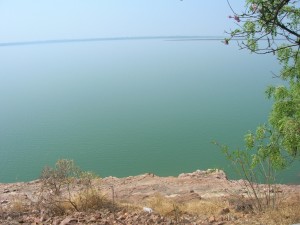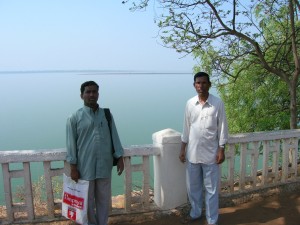I remember my past birth and I have a faint recollection of its events too. In my past life I was a yogi devoted to the practices of yoga, but somehow the practices remained incomplete. In order to complete the practices of yoga I have taken birth and come to this plane. Even in my student life I did never lose sight of this aim, and all the while I was endeavouring to achieve the object. While I was a student I was often assailed by mystic moods – moods of divine joy, of love, of ecstasy and at times of deep agony. My mind was, as it were, like a pendulum swinging to and fro between a tear and a smile, between ecstasy and agony, between depression and elation. After a few years these moods subsided and I regained the balance of my mind.
In my student life the attention was divided between the studies and sadhana. So I could not go much ahead in the practices of yoga. Immediately after my graduation I took up the order of Swami with an avowed object to devote my entire energies to sadhana. But what happened was a strange thing. Instead of devoting my attention to the practices of yoga, I got myself involved in social activities and in preaching and propagating the ideals of philosophy and religion. Many a time I have had the experience of visions and voices. For the first time in the year 1942 I heard an inner Voice clear and audible, which commanded me to give up this work. But I paid no heed to the Voice. Exactly after ten years I again heard the inner Voice which dictated me to develop the yogic sadhana. This time I paid heed to the Voice, but in a compromising spirit. I adopted the way of moderation dividing my attention between action and contemplation. This did not yield me any tangible results, this did not pay me any creditable dividends. For the third time in the year 1962, again after ten years, I heard the inner Voice, but this time the Voice was not only clear and audible but solemn and stern.
Shake, shake off delusion,
Wake, wake up, be free,
Take, take up sannyas.
I paid heed to the Voice, I gave up my mind and heart to its mandate. As a result of this, and after an endeavour of three years, Tapovana came into existence. On August 22, 1965 I took up the order of Vidvat-Sannyas, shut myself up in the ivory tower of isolation and solitude, devoting my entire energies to the practice of yoga which is so near and dear to my heart.
It is indeed gratifying to learn that my sadhana, for one full year was all smooth sailing without any break, without any disease, without any hindrance. I had to undergo the practices of yoga for more than 12 hours per day, yet I did not feel fatigue. I confess that this is due to three causes: firstly, the spirit of Sannyas entered into my body and drove away the dregs of disease; secondly, my firm resolution to pursue the yogic practices under any circumstances did not allow any break to step in the sadhana; thirdly, the grace of God and the good will of many well-wishers of mine held all hindrances in abeyance. It is said that many sadhakas are frightened by illness in the course of yoga. Diseases come to sadhakas as a part of necessary process for the purification of the body. For profound alterations are needed in the brain cells, in the nervous system, in the digestive and secretive processes and they cannot be effected without some physical disturbance, but it will never be more than is necessary for the sadhana. Thank God, in my case, no such thing ever happened.
The aim of my anushtana or penance is to gain purity – purity of the body, of the mind, of the heart, and of the will; purity of the word, deed and thought. To gain purity is the essential condition of Sannyas-dharma. Not to attain occult powers, not even to attain the sunyata or void state is the aim of sannyas. A true sannyasi is not after siddhi, i.e., occult powers, but he is after shuddhi, i.e., sublime purity. Powers follow purity as the shadow follows the body.
Maharshi Patanjali, in his Yoga-sutra, tells us that there are five sources from which spring the occult powers.They are * Janma, Osadhi, Mantra, Tapas, and Samadhi.
There are some great souls who are perfect by birth, they come to the earth plane simply to reveal the ways of God to man. Such souls are few and far between. There are certain herbs which can confer upon man peculiar powers. In my case these two are inadmissible, for, I am neither a perfect man by birth nor do I possess any knowledge of the herbs. But the remaining three – mantra, tapas and samadhi, I do follow in my course. I spend a little time in samadhi, a little more time in the repetition of mantra but a great amount of time in tapas or austerities. Pranayama occupies the prominent part of my tapas. There are three grades in * * pranayama – prakrita, vaikrita and kumbhaka. The characteristic of the first grade is profuse perspiration or sveda (Sanskrit) of the second grade is shivering and quaking or kampa (Sanskrit) of the third grade is levitation or Utthaana (Sanskrit). In 1932 while I was practising pranayama at Naviluteerth* * *, for the first time I had experience of levitation and that was also my last experience.
From left to right – Presently, Naviluteerth has a dam on Malprabha river, Gurudeva’s meditation spot is currently under water, Naviluteerth spot where Gurudeva meditated in 1932, Beautiful Naviluteerth, now under Malprabha dam’s back-water
These photos are webmaster’s addition in original article.
During my yogic practices in Tapovana I have had the experience of the rise of lunar breath (chandra-amrut) in the day and of the solar breath (Surya-amrut) at night. This is indeed a great benefit. Its immediate result is diminution of hunger and thirst; for the last one year I have not taken water; dependance upon milk and fruits also has been considerably reduced. If the rhythmic rise and fall of the lunar and solar breaths continue for ever, a yogi can easily dispense with food and drink and can survive for a long time.
…..Om…..Om…..Om…..Om…..Om…..
Webmaster’s Note
*1. Janma – Birth
2. Osadhi – Medicinal herbs
3. Mantra – A divine formula with letters combined to form certain words containing latent spiritual power.
4. Tapas – Austerity or Penance
5. Samadhi – Ecstasy with God, complete absorption in God or Emotional Equilibriam.
( Maharshi Patanjali’s Yogasutra Kaivalya-Pada Aphorism I)
* *The author of Sivayoga Pradipika describes three kinds of Pranayama: Prakrita, Vaikrita and Kevala Kumbhaka. “If the Prana is in the form of breath inhaled and exhaled, on account of its natural quality of going out and coming in, the Pranayama is known as Prakrita. If the Prana is restrained by the threefold means of throwing out, taking in and stopping the breath in accordance with the rules prescribed in the Sastras, it is called Vaikrita or artificial. But with great men who have risen above these two kinds of restraining breath, the sudden restraining of the vital currents directly (without inspiration and expiration), is Kevala Kumbhaka. Prakrita Pranayama belongs to Mantra Yoga. Vaikrita belongs to Laya Yoga.” — Swami Shivananda of Divine Life Society, Rishikesh.
* * *Naviluteerth is a place on the banks of river Malaprabha, near Munavalli in Belgaum District of Karnataka state of India





